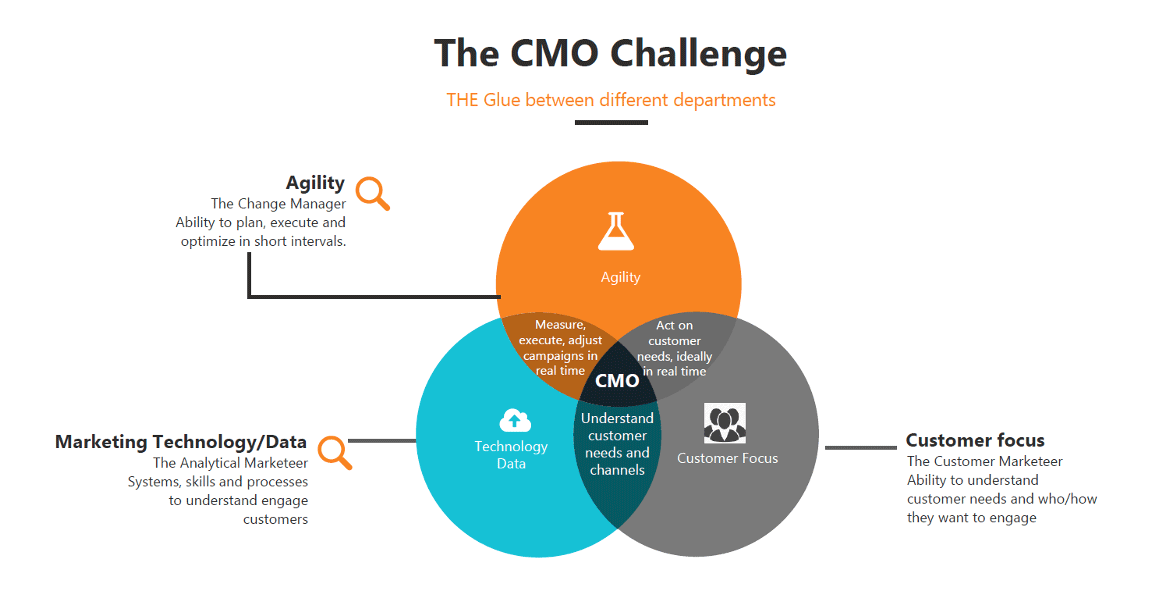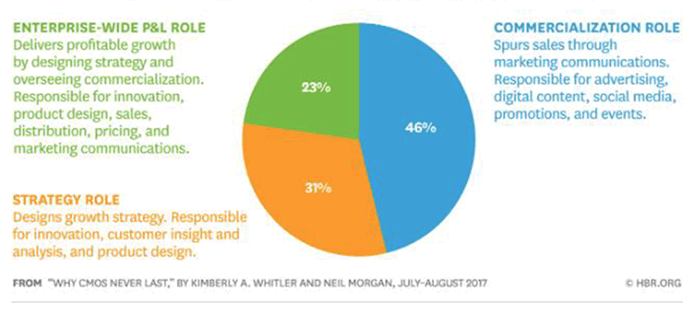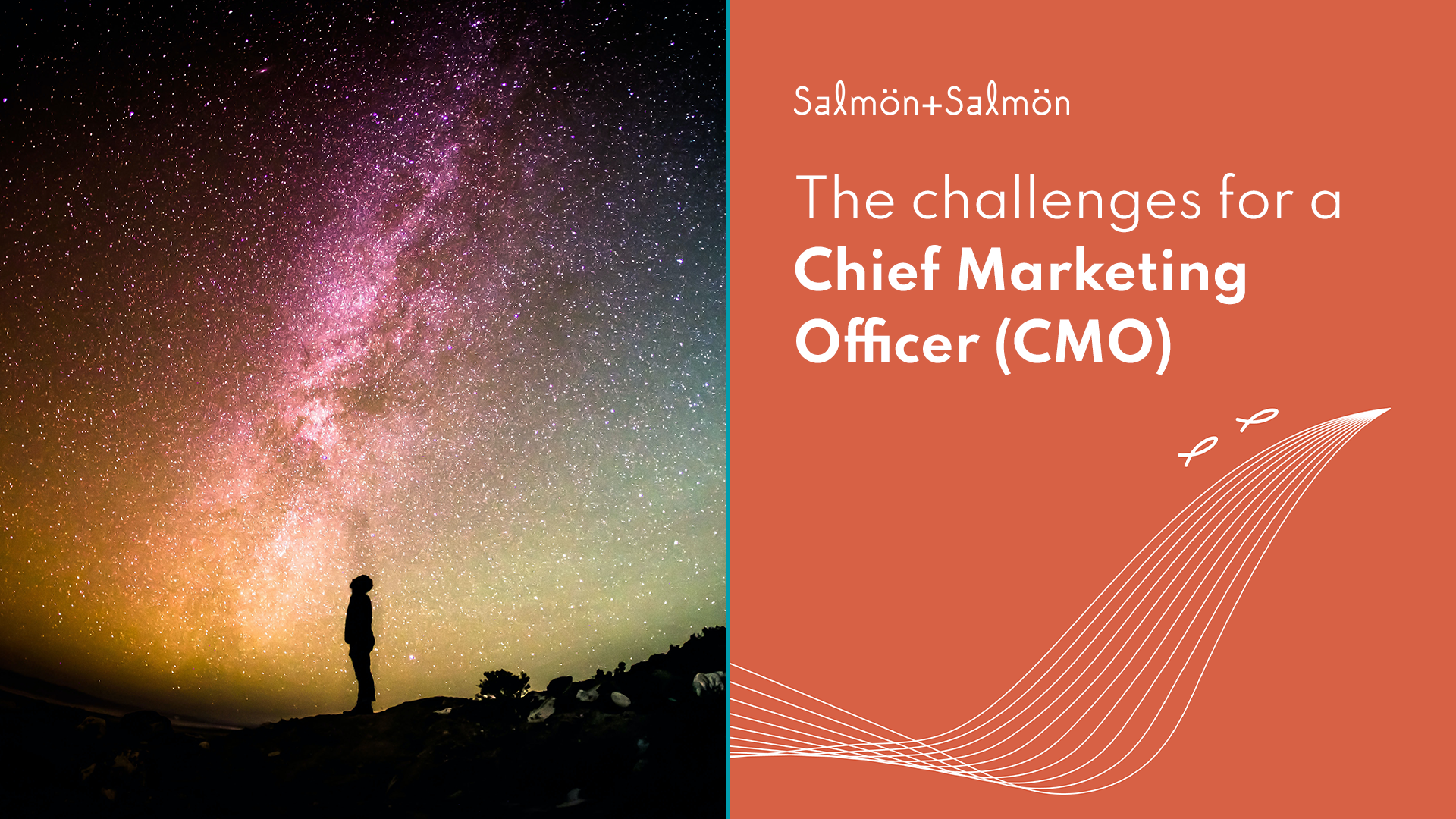The role of a CMO in B2B, and per extension also B2C, has become extremely challenging these days. Often, it is not even clear what the C-suite and the board expect from a Chief Marketing Officer. Should he have a clear customer focus, or act more as a technology/data marketeer? Or is he the major change manager, being the glue between the different departments? Or all 3 in one?

The CMO of today is being confronted with 3 main issues:
- Which products and services will add the most customer value?
- What content and programs in which channels will represent these values best?
- How to align resources, execute marketing programs, and measure value?
For years, CMOs have handled traditional marketing roles such as branding, advertising, events, and lead generation. With that came — let’s be honest — a lot of guessing. Think about this classic when asking to increase the marketing budget: “We guess the ROI will be X”. Without the right tooling or resources, it’s virtually impossible to drive SMART insights.
However, in the digital age, with addressable channels, AI, hyper-personalization, and strategic assets such as customer data and insights, their mandate and measurement approach must change. Gartner research reconfirms: customer experience is key for CMOs! This is how they see it:
If you’re customer-first and do it in a smart way, then it can help the company. So what we really coach our clients on is to understand their data, to tie the satisfaction scores back to operational and transactional data, and to be able to tell leaders why it matters.
The value of a ‘Customer Value Officer’ (CVO)
Still, being customer-first remains one of their major challenges when it comes to empowerment and competences. Forrester states that companies acting with a CMO who actually is a chief value officer are performing better.
CX (customer experience) is essential to “the mix.” CMOs will become story makers, placing customers at the center of their company values, experiences, and processes. For instance, the Apple Watch allows consumers to contribute their critical data to health research; Apple, in return, gets credit for helping save lives. Businesses with any amount of disconnection or fragmentation in the brand will find growth elusive, feeling the brunt of disruption in this age of customer control.
Now more than ever, customers expect to be heard, listened to, understood and answered. Every interactions asks for relevance and value, as customers care less and less about rebrands or catchy TV ads. Whether your customer buys a candy bar or a multimillion-euro software system, he is attracted by the same thing: trust and consistency. As such, every organization needs a C-level executive that understands this, champions it, and is accountable to that new strategy.
The new mission for the Customer Value Officer
So, does marketing have that leader? That very much depends on the person raising their hand to assume not only a new title but a new mission.
Recently we have seen the evolution towards some new titles such as Chief People Officer, Chief Revenue Officer, Chief Analytics Offer, and so on. Sadly, new fancy titles don’t solve old stubborn issues. We need to work cross-functional if we truly want to deliver a delighting experience to the end user. To energize this marketing approach, the organization needs to collaborate transversally with a new data-driven and customer-centric mandate.
Most importantly, they should demand all initiatives run with new customer-centric strategies, demand strict quantitative measurement in terms of customer value-added, and endeavor to prove lift quickly.
54% of customers have higher expectations for customer service today compared to one year ago. This percentage jumps to 66% for consumers between the age of 18 and 34.
To be able to react to this trend, next-gen CMOs need to fully understand customer value and how they can create greater amounts of it using data and analytics as strategic enablers. This new approach will separate traditional CMO’s from customer-driven CVOs, who always increase value while living on the edge of technology and data, with customer needs as holy grail.

Customers are in control: continuous relevance creates value
Do CMOs take enough advantage of the existing opportunity window?
The common denominator in those pursuits are convenience, consistency and purpose of the brand. To be relevant, CMOs must demand all inbound and outbound customer engagements go through a single system to manage, measure, and optimize customer value – keeping in mind that customers are in control:
- They control the relationship. Companies can nurture them, but customers decide when, where, and how much they will engage.
- Customers measure value during every interaction and expect brands to know what they need and expect. This might be surprising though…
- It would be wrong to to think brands impact and control a user’s assessment of his multichannel experience and its worth. Every interaction, service, product and personalized experience must always add value to the user. Doesn’t every person wants to be loved and appreciated?
That’s where the role of the CVO comes in. Senior business leaders who wish to drive revenue and growth must prioritize close alignment between sales and marketing and innovation and technology. However, siloed processes, data and even technology can hamper growth efforts, whilst priorities budgets and senior personalities often remain in conflict.
To drive common process adoption, some companies are championing a change that introduces the notion of revenue operations. Although the term has various interpretations and applications, revenue operations brings the operational work of sales, marketing and customer success together under one roof –typically owned by a chief revenue officer (CRO).
Conclusion: bringing Value is a team effort
The CMO must work to align many things to realize customer value optimization. He can only maximize value with the right cultural, organizational, functional, data, and technology architecture; all working in concert. To be able to track measurable results, sales and marketing need to work together. Cost saving and rapidity are key. This can be gained by strong data insights and quick testing with new technologies and toolings.
The cliché is as true as can be: teamwork is dreamwork.

